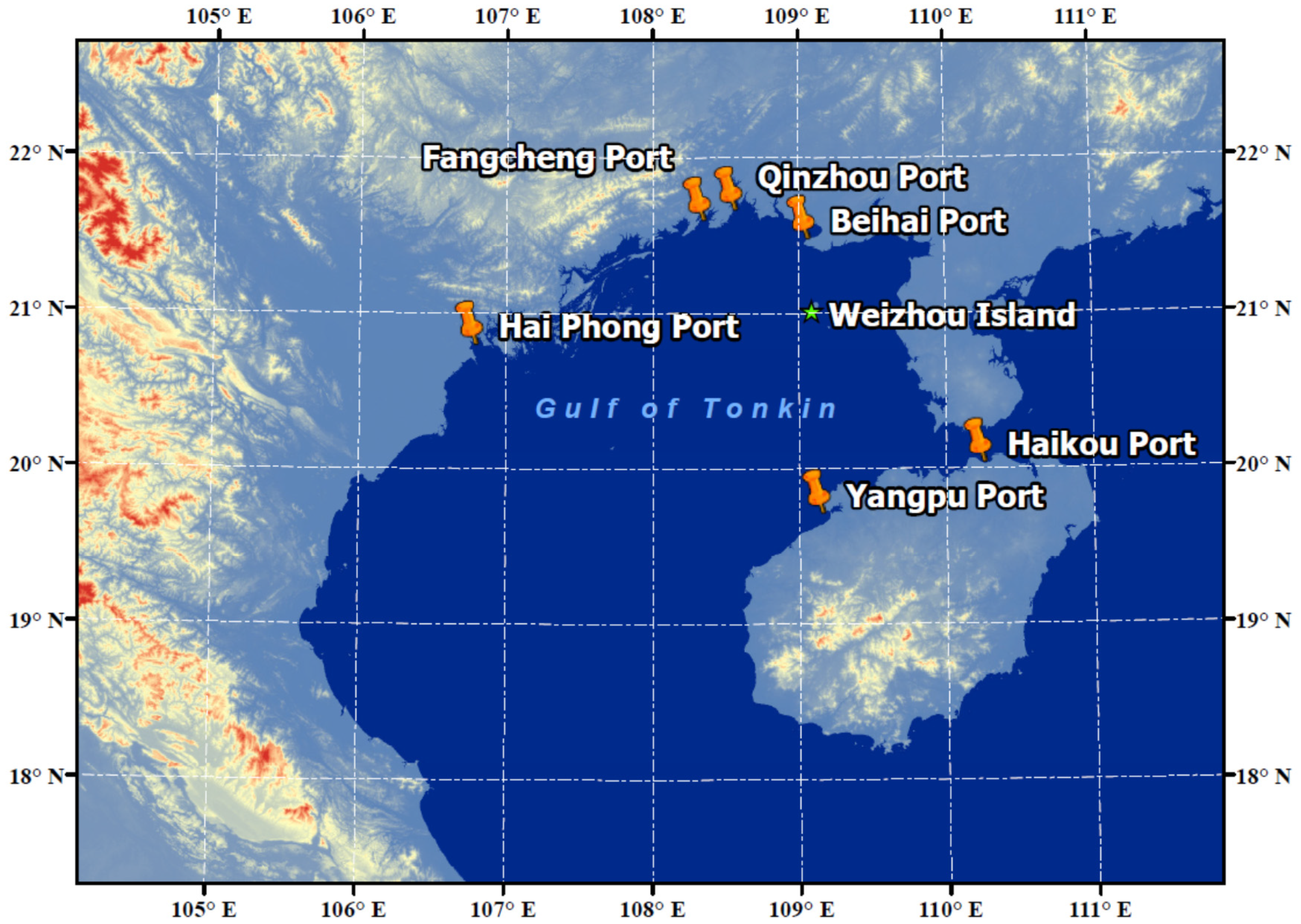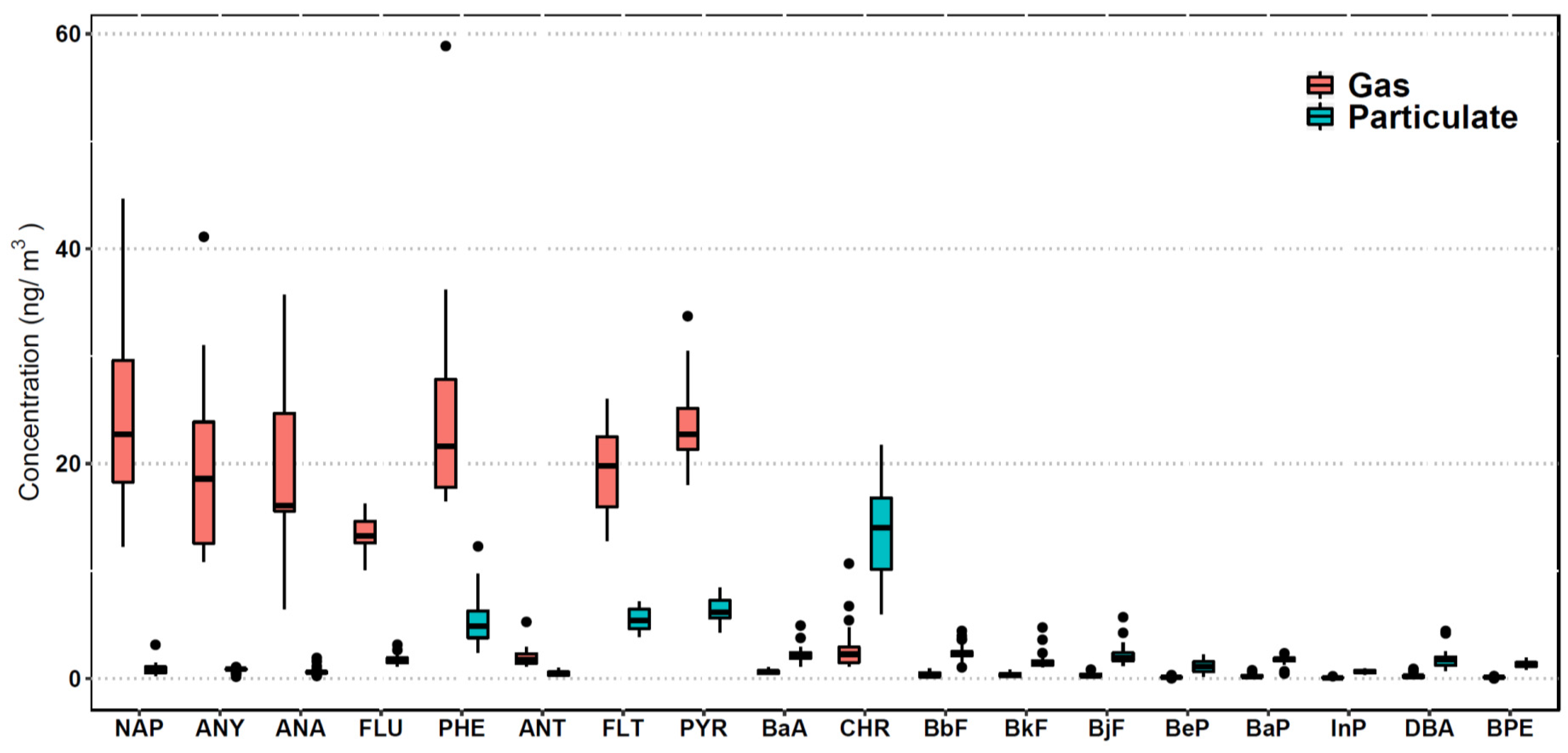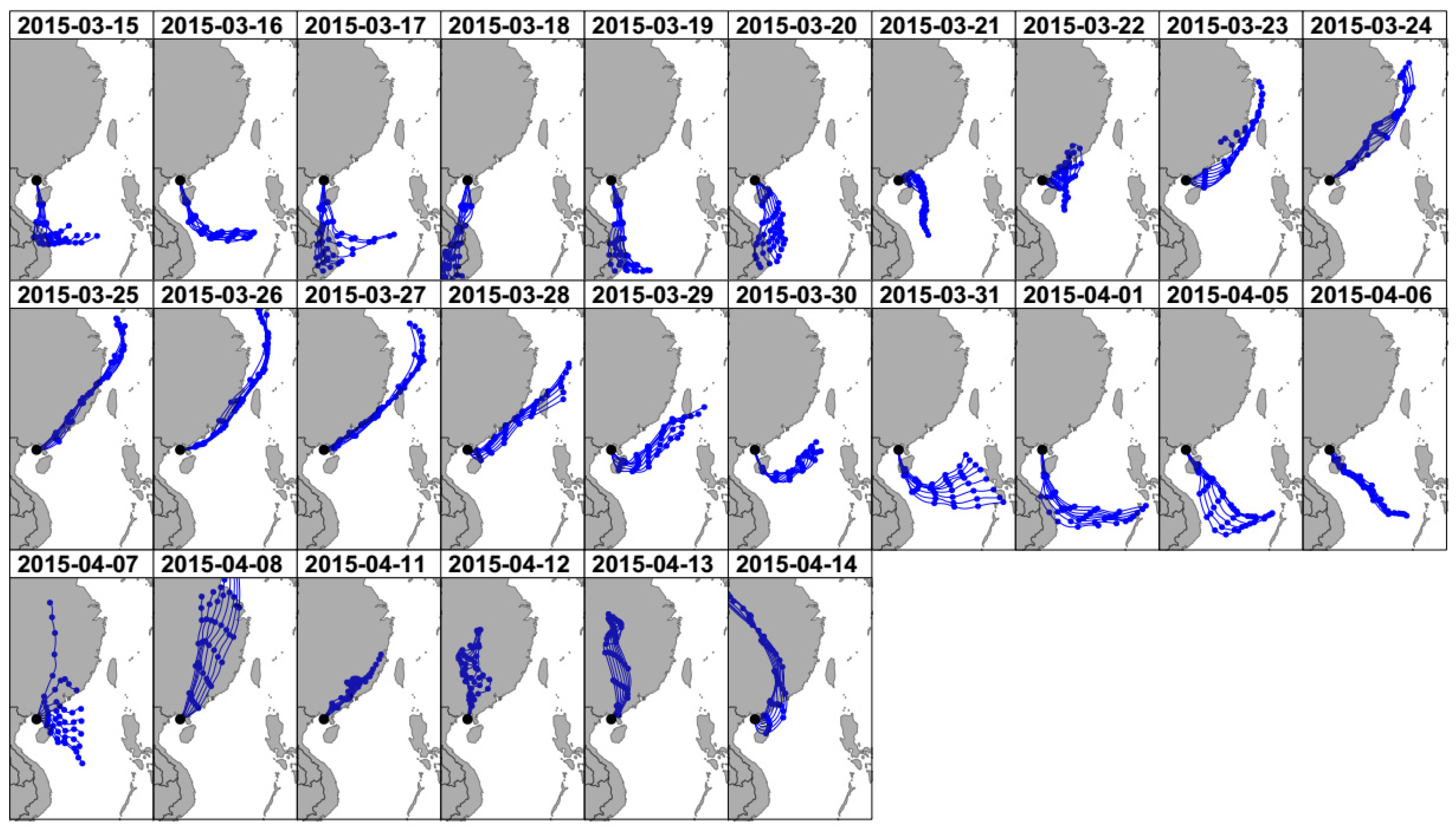Levels, Sources and Toxicity Risks of Polycyclic Aromatic Hydrocarbons at an Island Site in the Gulf of Tonkin
Abstract
:1. Introduction
2. Materials and Methods
2.1. Sample Collection
2.2. Chemicals
2.3. Chemical Analysis
2.4. Back Trajectory Cluster Analysis
2.5. Toxicity Risk Assessment
3. Results and Discussion
3.1. Concentrations of PAHs
3.2. Diagnostic Sources of PAHs
3.3. Assessment of Toxicity Risks
4. Conclusions
Author Contributions
Funding
Conflicts of Interest
References
- Ames, B.N.; McCann, J.; Yamasaki, E. Methods for detecting carcinogens and mutagens with the salmonella/mammalian-microsome mutagenicity test. Mutat. Res. 1975, 31, 347–363. [Google Scholar] [CrossRef]
- Epstein, S.S.; Fujii, K.; Asahina, S. Carcinogenicity of a composite organic extract of urban particulate atmospheric pollutants following subcutaneous injection in infant mice. Environ. Res. 1979, 19, 163–176. [Google Scholar] [CrossRef]
- Pongpiachan, S.; Ho, K.F.; Cao, J. Abstract: Effects of Biomass and Agricultural Waste Burnings on Diurnal Variation and Vertical Distribution of OC/EC in Hat-Yai City, Thailand. Asian J. Appl. Sci. 2014, 23, 360–374. [Google Scholar] [CrossRef] [Green Version]
- Ravindra, K.; Sokhi, R.; Vangrieken, R. Atmospheric polycyclic aromatic hydrocarbons: Source attribution, emission factors and regulation. Atmos. Environ. 2008, 42, 2895–2921. [Google Scholar] [CrossRef] [Green Version]
- Zhang, Y.; Tao, S. Global atmospheric emission inventory of polycyclic aromatic hydrocarbons (PAHs) for 2004. Atmos. Environ. 2009, 43, 812–819. [Google Scholar] [CrossRef]
- Yang, X.Y.; Igarashi, K.; Tang, N.; Lin, J.M.; Wang, W.; Kameda, T.; Toriba, A.; Hayakawa, K. Indirect- and direct-acting mutagenicity of diesel, coal and wood burning-derived particulates and contribution of polycyclic aromatic hydrocarbons and nitropolycyclic aromatic hydrocarbons. Mutat. Res. Genet. Toxicol. Environ. Mutagene. 2010, 695, 29–34. [Google Scholar] [CrossRef]
- Yang, X.; Liu, S.; Xu, Y.; Liu, Y.; Chen, L.; Tang, N.; Hayakawa, K. Emission factors of polycyclic and nitro-polycyclic aromatic hydrocarbons from residential combustion of coal and crop residue pellets. Environ. Pollut. 2017, 231, 1265–1273. [Google Scholar] [CrossRef]
- Araki, Y.; Tang, N.; Ohno, M.; Kameda, T.; Toriba, A.; Hayakawa, K. Analysis of atmospheric polycyclic aromatic hydrocarbons and nitropolycyclic aromatic hydrocarbons in gas/particle phases separately collected by a high-volume air sampler equipped with a column packed with XAD-4 resin. J. Health Sci. 2009, 55, 77–85. [Google Scholar] [CrossRef] [Green Version]
- Keyte, I.J.; Harrison, R.M.; Lammel, G. Chemical reactivity and long-range transport potential of polycyclic aromatic hydrocarbons-a review. Chem. Soc. Rev. 2013, 42, 9333–9391. [Google Scholar] [CrossRef]
- Masclet, P.; Mouvier, G.; Nikolaou, K. Relative decay index and sources of polycyclic aromatic hydrocarbons. Atmos. Environ. 1986, 20, 439–446. [Google Scholar] [CrossRef]
- Simcik, M.; Franz, T.P.; Zhang, H.; Eisenreich, S.J. Gas-particle partitioning of PCBs and PAHs in the Chicago urban and adjacent coastal atmosphere: States of equilibrium. Environ. Sci. Technol. 1998, 32, 251–257. [Google Scholar] [CrossRef]
- Yang, X.-Y.; Okada, Y.; Tang, N.; Matsunaga, S.; Tamura, K.; Lin, J.-M.; Kameda, T.; Toriba, A.; Hayakawa, K. Long-range transport of polycyclic aromatic hydrocarbons from China to Japan. Atmos. Environ. 2007, 41, 2710–2718. [Google Scholar] [CrossRef]
- NBSC. China Statistical Yearbook 2018; China Statistics Press: Beijing, China, 2019.
- Fang, Z. Grey Correlation Analysis between Industrial Structures and Carbon Emission in Guangxi Beibu Gulf Economic Zone. Int. J. Smart Home 2016, 10, 75–82. [Google Scholar] [CrossRef]
- Yin, X.; Huang, Z.; Zheng, J.; Yuan, Z.; Zhu, W.; Huang, X.; Chen, D. Source contributions to PM2.5 in Guangdong province, China by numerical modeling: Results and implications. Atmos. Res. 2017, 186, 63–71. [Google Scholar] [CrossRef]
- Lan, Z.; Zhang, B.; Huang, X.; Qiao, Z.; Yuan, J.; Zeng, L.; Min, H.; He, L. Source apportionment of PM2.5 light extinction in an urban atmosphere in China. J. Environ.Sci. 2018, 63, 277–284. [Google Scholar] [CrossRef] [PubMed]
- Yang, X.; Xu, J.; Bi, F.; Zhang, Z.; Chen, Y.; He, Y.; Han, F.; Zhi, G.; Liu, S.; Meng, F. Aircraft measurement over the Gulf of Tonkin capturing aloft transport of biomass burning. Atmos. Environ. 2018, 182, 41–50. [Google Scholar] [CrossRef]
- Reid, J.S.; Xian, P.; Hyer, E.J.; Flatau, M.K.; Ramirez, E.M.; Turk, F.J.; Sampson, C.R.; Zhang, C.; Fukada, E.M.; Maloney, E.D. Multi-scale meteorological conceptual analysis of observed active fire hotspot activity and smoke optical depth in the Maritime Continent. Atmos. Chem. Phys. 2012, 12, 2117–2147. [Google Scholar] [CrossRef] [Green Version]
- Yen, M.C.; Peng, C.-M.; Chen, T.-C.; Chen, C.-S.; Lin, N.-H.; Tzeng, R.-Y.; Lee, Y.-A.; Lin, C.-C. Climate and weather characteristics in association with the active fires in northern Southeast Asia and spring air pollution in Taiwan during 2010 7-SEAS/Dongsha Experiment. Atmos. Environ. 2012, 78, 35–50. [Google Scholar] [CrossRef]
- Chan, L.Y.; Chan, C.Y.; Liu, H.Y.; Christopher, S.; Oltmans, S.J.; Harris, J.M. A case study on the biomass burning in southeast Asia and enhancement of tropospheric ozone over Hong Kong. Geophys. Res. Lett. 2000, 27, 1479–1482. [Google Scholar] [CrossRef] [Green Version]
- Ramanathan, V.; Agrawal, M.; Akimoto, H. Atmospheric Brown Clouds: Regional Assessment Report with Focus on Asia; United Nations Environment Programme: Bangkok, Thailand, 2008. [Google Scholar]
- CPA. Chinese Ports Yearbook; Chinese Port Magazine: Shanghai, China, 2019. [Google Scholar]
- Lawson, S.J.; Keywood, M.D.; Galbally, I.E.; Gras, J.L.; Cainey, J.M.; Cope, M.E.; Krummel, P.B.; Fraser, P.J.; Steele, L.P.; Bentley, S.T.; et al. Biomass burning emissions of trace gases and particles in marine air at Cape Grim, Tasmania. Atmos. Chem. Phys. 2015, 15, 13393–13411. [Google Scholar] [CrossRef] [Green Version]
- Murano, K.; Mukai, H.; Hatakeyama, S.; Jang, E.S.; Uno, I. Trans-boundary air pollution over remote islands in Japan: Observed data and estimates from a numerical model. Atmos. Environ. 2000, 34, 5139–5149. [Google Scholar] [CrossRef]
- Saliba, M.; Ellul, R.; Camilleri, L.; Güsten, H. A 10-year study of background surface ozone concentrations on the island of Gozo in the Central Mediterranean. J. Atmos. Chem. 2008, 60, 117–135. [Google Scholar] [CrossRef] [Green Version]
- Tsapakis, M.; Stephanou, E.G. Diurnal Cycle of PAHs, Nitro-PAHs, and oxy-PAHs in a High Oxidation Capacity Marine Background Atmosphere. Environ. Sci. Technol. 2007, 41, 8011–8017. [Google Scholar] [CrossRef] [PubMed]
- Lee, J.Y.; Kim, Y.P.; Kaneyasu, N.; Kumata, H.; Kang, C.-H. Particulate PAHs levels at Mt. Halla site in Jeju Island, Korea: Regional background levels in northeast Asia. Atmos. Res. 2008, 90, 91–98. [Google Scholar] [CrossRef]
- Zhang, J.; Yang, L.; Mellouki, A.; Chen, J.; Chen, X.; Gao, Y.; Jiang, P.; Li, Y.; Yu, H.; Wang, W. Diurnal concentrations, sources, and cancer risk assessments of PM2.5-bound PAHs, NPAHs, and OPAHs in urban, marine and mountain environments. Chemosphere 2018, 209, 147–155. [Google Scholar] [CrossRef] [PubMed]
- Kaneyasu, N.; Takada, H. Seasonal variations of sulfate, carbonaceous species (black carbon and polycyclic aromatic hydrocarbons), and trace elements in fine atmospheric aerosols collected at subtropical islands in the East China Sea. J. Geophys. Res. Atmos. 2004, 109(D6), D06211. [Google Scholar] [CrossRef]
- Wang, X.; Zong, Z.; Tian, C.; Chen, Y.; Zhang, G. Assessing on toxic potency of PM2.5-bound polycyclic aromatic hydrocarbons at a national atmospheric background site in North China. Sci. Total Environ. 2018, 612, 330–338. [Google Scholar] [CrossRef]
- Carslaw, D.C.; Ropkins, K. openair—An R package for air quality data analysis. Environ. Modell. Softw. 2011, 27, 52–61. [Google Scholar] [CrossRef]
- Cecinato, A. Polynuclear aromatic hydrocarbons (PAH), benz(a)pyrene (BaPY) and nitrated-PAH (N-PAH) in suspended particulate matter (Proposal for revision of the Italian Reference Method). Anal. Chim. 1997, 87, 483–496. [Google Scholar]
- Bosveld, A.T.C.; De Bie, P.A.F.; Van den Brink, N.W.; Jongepier, H.; Klomp, A.V. In vitro EROD induction equivalency factors for the 10 PAHs generally monitored in risk assessment studies in the Netherlands. Chemosphere 2002, 49, 75–83. [Google Scholar] [CrossRef]
- Durant, J.L.; Busby, W.F., Jr.; Lafleur, A.L.; Penman, B.W.; Crespi, C.L. Human cell mutagenicity of oxygenated, nitrated and unsubstituted polycyclic aromatic hydrocarbons associated with urban aerosols. Mutat. Res. Genet. Tox. 1996, 371, 123–157. [Google Scholar] [CrossRef]
- Liu, J.; Li, J.; Lin, T.; Liu, D.; Xu, Y.; Chaemfa, C.; Qi, S.; Liu, F.; Zhang, G. Diurnal and nocturnal variations of PAHs in the Lhasa atmosphere, Tibetan Plateau: Implication for local sources and the impact of atmospheric degradation processing. Atmos. Res. 2013, 124, 34–43. [Google Scholar] [CrossRef]
- Wang, W.; Simonich, S.L.M.; Wang, W.; Giri, B.; Zhao, J.; Xue, M.; Cao, J.; Lu, X.; Tao, S. Atmospheric polycyclic aromatic hydrocarbon concentrations and gas/particle partitioning at background, rural village and urban sites in the North China Plain. Atmos. Res. 2011, 99, 197–206. [Google Scholar] [CrossRef]
- Yang, L.; Suzuki, G.; Zhang, L.; Zhou, Q.; Zhang, X.; Xing, W.; Shima, M.; Yoda, Y.; Nakatsubo, R.; Hiraki, T.; et al. The Characteristics of Polycyclic Aromatic Hydrocarbons in Different Emission Source Areas in Shenyang, China. Int. J. Environ. Res. Public Health 2019, 16, 2817. [Google Scholar] [CrossRef] [PubMed] [Green Version]
- Cheng, J.-O.; Ko, F.-C.; Lee, C.-L.; Fang, M.-D. Atmospheric polycyclic aromatic hydrocarbons (PAHs) of southern Taiwan in relation to monsoons. Environ. Sci. Pollut. Res. 2016, 23, 15675–15688. [Google Scholar] [CrossRef] [PubMed]
- Kim, J.Y.; Lee, J.Y.; Choi, S.D.; Kim, Y.P.; Ghim, Y.S. Gaseous and particulate polycyclic aromatic hydrocarbons at the Gosan background site in East Asia. Atmos. Environ. 2012, 49, 311–319. [Google Scholar] [CrossRef]
- Yang, Y.; Guo, P.; Zhang, Q.; Li, D.; Zhao, L.; Mu, D. Seasonal variation, sources and gas/particle partitioning of polycyclic aromatic hydrocarbons in Guangzhou, China. Sci. Total Environ. 2010, 408, 2492–2500. [Google Scholar] [CrossRef]
- Zhao, J.; Zhang, F.; Xu, L.; Chen, J.; Xu, Y. Spatial and temporal distribution of polycyclic aromatic hydrocarbons (PAHs) in the atmosphere of Xiamen, China. Sci. Total Environ. 2011, 409, 5318–5327. [Google Scholar] [CrossRef]
- Ma, W.L.; Sun, D.-Z.; Shen, W.-G.; Yang, M.; Qi, H.; Liu, L.-Y.; Shen, J.-M.; Li, Y.-F. Atmospheric concentrations, sources and gas-particle partitioning of PAHs in Beijing after the 29th Olympic Games. Environ. Pollut. 2011, 159, 1794–1801. [Google Scholar] [CrossRef]
- Barrado, A.I.; García, S.; Sevillano, M.L.; Rodríguez, J.A.; Barrado, E. Vapor-phase concentrations of PAHs and their derivatives determined in a large city: Correlations with their atmospheric aerosol concentrations. Chemosphere 2013, 93, 1678–1684. [Google Scholar] [CrossRef] [PubMed]
- Gregoris, E.; Argiriadis, E.; Vecchiatoa, M.; Zambon, S.; De Pieri, S.; Donateo, A.; Contini, D.; Piazza, R.; Barbante, C.; Gambaro, A. Gas-particle distributions, sources and health effects of polycyclic aromatic hydrocarbons (PAHs), polychlorinated biphenyls (PCBs) and polychlorinated naphthalenes (PCNs) in Venice aerosols. Sci. Total Environ. 2014, 476–477, 393–405. [Google Scholar] [CrossRef] [PubMed]
- Ho, K.F.; Lee, S.C.; Chiu, G.M.Y. Characterization of selected volatile organic compounds, polycyclic aromatic hydrocarbons and carbonyl compounds at a roadside monitoring station. Atmos. Environ. 2002, 36, 57–65. [Google Scholar] [CrossRef]
- Chen, F.; Hu, W.; Zhong, Q. Emissions of particle-phase polycyclic aromatic hydrocarbons (PAHs) in the Fu Gui-shan Tunnel of Nanjing, China. Atmos. Res. 2013, 124, 53–60. [Google Scholar] [CrossRef]
- Wang, J.; Li, X.; Jiang, N.; Zhang, W.; Zhang, R.; Tang, X. Long term observations of PM2.5-associated PAHs: Comparisons between normal and episode days. Atmos. Environ. 2015, 104, 228–236. [Google Scholar] [CrossRef]
- Kulkarni, P.; Venkataraman, C. Atmospheric polycyclic aromatic hydrocarbons in Mumbai, India. Atmos. Environ. 2000, 34, 2785–2790. [Google Scholar] [CrossRef]
- Zhang, K.; Shang, X.; Herrmann, H.; Meng, F.; Mo, Z.; Chen, J.; Lv, W. Approaches for identifying PM2.5 source types and source areas at a remote background site of South China in spring. Sci. Total Environ. 2019, 691, 1320–1327. [Google Scholar] [CrossRef]
- Zheng, L.; Yang, X.; Lai, S.; Ren, H.; Yue, S.; Zhang, Y.; Huang, X.; Gao, Y.; Sun, Y.; Wang, Z.; et al. Impacts of springtime biomass burning in the northern Southeast Asia on marine organic aerosols over the Gulf of Tonkin, China. Environ. Pollut. 2018, 237, 285–297. [Google Scholar] [CrossRef]
- Pongpiachan, S.; Hattayanone, M.; Choochuay, C.; Mekmok, R.; Wuttijak, N.; Ketratanakul, A. Enhanced PM10 bounded PAHs from shipping emissions. Atmos. Environ. 2015, 108, 13–19. [Google Scholar] [CrossRef]
- Tobiszewski, M.; Namieśnik, J. PAH diagnostic ratios for the identification of pollution emission sources. Environ. Pollut. 2012, 162, 110–119. [Google Scholar] [CrossRef]
- Yunker, M.B.; Macdonald, R.W.; Vingarzan, R.; Mitchell, R.H.; Goyette, D.; Sylvestre, S. PAHs in the Fraser River basin: A critical appraisal of PAH ratios as indicators of PAH source and composition. Org. Geochem. 2002, 33, 489–515. [Google Scholar] [CrossRef]
- Khalili, N.R.; Scheff, P.A.; Holsen, T.M. PAH source fingerprints for coke ovens, diesel and, gasoline engines, highway tunnels, and wood combustion emissions. Atmos. Environ. 1995, 29, 533–542. [Google Scholar] [CrossRef]
- Mandalakis, M.; Tsapakis, M.; Tsoga, A.; Stephanou, E.G. Gas-particle concentrations and distribution of aliphatic hydrocarbons, PAHs, PCBs and PCDD/Fs in the atmosphere of Athens (Greece). Atmos. Environ. 2002, 36, 4023–4035. [Google Scholar] [CrossRef]
- Bhargava, A.; Khanna, R.N.; Bhargava, S.K.; Kumar, S. Exposure risk to carcinogenic PAHs in indoor-air during biomass combustion whilst cooking in rural India. Atmos. Environ. 2004, 38, 4761–4767. [Google Scholar] [CrossRef]
- Larsen, J.C.; Larsen, P.B. Chemical carcinogens. In Air Pollution and Health; Hester, R., Harrison, R., Eds.; Royal Society of Chemistry: Cambridge, UK, 1998; pp. 33–56. [Google Scholar]
- Liu, W.X.; Dou, H.; Wei, Z.C.; Chang, B.; Qiu, W.X.; Liu, Y.; Tao, S. Emission characteristics of polycyclic aromatic hydrocarbons from combustion of different residential coals in North China. Sci. Total Environ. 2009, 407, 1436–1446. [Google Scholar] [CrossRef]
- Lu, H.; Zhu, L.; Chen, S. Pollution level, phase distribution and health risk of polycyclic aromatic hydrocarbons in indoor air at public places of Hangzhou, China. Environ. Pollut. 2008, 152, 569–575. [Google Scholar] [CrossRef]






| No. | Compound | Abbreviation | Rings |
|---|---|---|---|
| 1 | Naphthalene | NAP | 2 |
| 2 | Acenaphthylene | ANY | 3 |
| 3 | Acenaphthene | ANA | 3 |
| 4 | Fluorene | FLU | 3 |
| 5 | Phenanthrene | PHE | 3 |
| 6 | Anthracene | ANT | 3 |
| 7 | Fluoranthene | FLT | 4 |
| 8 | Pyrene | PYR | 4 |
| 9 | Benz(a)anthracene | BaA | 4 |
| 10 | Chrysene | CHR | 4 |
| 11 | Benzo(b)fluoranthene | BbF | 5 |
| 12 | Benzo(k)fluoranthene | BkF | 5 |
| 13 | Benzo(j)fluoranthene | BjF | 5 |
| 14 | Benzo(e)pyrene | BeP | 5 |
| 15 | Benzo(a)pyrene | BaP | 5 |
| 16 | Indeno(1,2,3-cd)pyrene | InP | 6 |
| 17 | Dibenz(a,h)anthracene | DBA | 5 |
| 18 | Benzo(g,h,i)perylene | BPE | 6 |
| PAH | TCDD-IEFs | IDMs | PAH | TCDD-IEFs | IDMs |
|---|---|---|---|---|---|
| NAP | - | - | CHR | 0.0001 | - |
| ANY | - | - | BbF | - | 7.8 |
| ANA | - | - | BkF | - | 3.8 |
| FLU | - | - | BjF | - | - |
| PHE | - | - | BeP | - | - |
| ANT | - | - | BaP | 0.0001 | 16.1 |
| FLT | 0.00000001 | 1.8 | InP | - | 0.8 |
| PYR | - | - | DBA | 0.0001 | 5.0 |
| BaA | 0.00001 | 2.0 | BPE | 0.00000001 | 0.3 |
| Type | Site | Particulate Phase | Gas Phase | ∑PAH Concentrations | Congener No. | References |
|---|---|---|---|---|---|---|
| Remote | Weizhou Island | 40.19–61.86 | 116.22–186.74 | 157.70–240.71 | 18 | This study |
| Tibetan Plateau | 4.4–60 | 79–350 | 87–360 | 15 | [35] | |
| Tuoji Island | 4.24–40.62 | - | - | 15 | ||
| Hengchun Peninsula | 0.01–1.36 | 0.39–2.31 | 0.42–2.79 | 16 | [38] | |
| Amami Sea and Japan Sea | 0.03–2.11 | - | - | 12 | [29] | |
| Jeju Island | 0.404–2.93 | - | - | 21 | [27] | |
| Gosan | 2.9 | 1.4 | - | 14 | [39] | |
| Urban | Donghe | 12.9–348.8 | - | 303.9–1616.5 | 16 | [36] |
| Beijing | 3.2–222.7 | - | 131.0–979.3 | 16 | [36] | |
| Guangzhou | 2.2–90.5 | 25.7–239.5 | 27.9–329.4 | 16 | [40] | |
| Shenyang | - | - | 92.6–316(cold season) | 9 | [37] |
| Gas Phase | Particulate Phase | Total PAHs | |
|---|---|---|---|
| ∑PAH7 | 4.65 | 23.95 | 28.60 |
| BaPE | 0.46 | 3.35 | 3.81 |
| TEQ | 0.00033 | 0.00172 | 0.00206 |
| IDMs | 44.71 | 77.37 | 122.08 |
© 2020 by the authors. Licensee MDPI, Basel, Switzerland. This article is an open access article distributed under the terms and conditions of the Creative Commons Attribution (CC BY) license (http://creativecommons.org/licenses/by/4.0/).
Share and Cite
Yang, X.; Liu, S.; Gao, Y.; Zhao, W.; Liu, Y.; Mao, J.; Mo, Z. Levels, Sources and Toxicity Risks of Polycyclic Aromatic Hydrocarbons at an Island Site in the Gulf of Tonkin. Int. J. Environ. Res. Public Health 2020, 17, 1338. https://doi.org/10.3390/ijerph17041338
Yang X, Liu S, Gao Y, Zhao W, Liu Y, Mao J, Mo Z. Levels, Sources and Toxicity Risks of Polycyclic Aromatic Hydrocarbons at an Island Site in the Gulf of Tonkin. International Journal of Environmental Research and Public Health. 2020; 17(4):1338. https://doi.org/10.3390/ijerph17041338
Chicago/Turabian StyleYang, Xiaoyang, Shijie Liu, Yuanguan Gao, Wenjuan Zhao, Yu Liu, Jingying Mao, and Zhaoyu Mo. 2020. "Levels, Sources and Toxicity Risks of Polycyclic Aromatic Hydrocarbons at an Island Site in the Gulf of Tonkin" International Journal of Environmental Research and Public Health 17, no. 4: 1338. https://doi.org/10.3390/ijerph17041338
APA StyleYang, X., Liu, S., Gao, Y., Zhao, W., Liu, Y., Mao, J., & Mo, Z. (2020). Levels, Sources and Toxicity Risks of Polycyclic Aromatic Hydrocarbons at an Island Site in the Gulf of Tonkin. International Journal of Environmental Research and Public Health, 17(4), 1338. https://doi.org/10.3390/ijerph17041338





